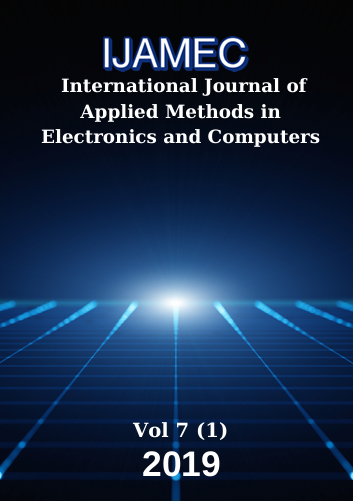Squirrel Cage Induction Motor Design and the Effect of Specific Magnetic and Electrical Loading Coefficient
DOI:
https://doi.org/10.18100/ijamec.461795Keywords:
Electrical loading coefficient, Induction motor design, Magnetic loading coefficient, Output coefficient, Performance analysis.Abstract
3-phase induction motors are widely used in industrial applications such as pumps, blowers, compressors, conveyors, etc. In addition, single-phase motors also have domestic use. For this reason, the design of the induction motor is of great importance. During the design, according to the parameters given as input, there are many situations that are contradictory to each other in order to achieve the goal. For example, if high efficiency is required, the motor size and the price will increase, and if lower price is required, other performance characteristics should be ignored. In the practical design of an induction motor, the designer has to comply with a number of constraints because of the large number of input variables. For this reason manual calculation becomes a very long and difficult process. To overcome this tiresome process, it is necessary to create a computer aided program or simulation model to determine the induction motor design parameters. In induction motor design, many parameters directly affect motor performance. Therefore, the selection of these parameters is of great importance. The C 0 coefficient, which takes place in the first steps of the design process, also has a great influence on the motor design. In this paper, a program for optimizing design of 3-phase induction motors written in MATLAB is presented. The structure of the program is modular and therefore can be modified for the various requirements of the induction motor design. C 0 constant (output coefficient), one of the design parameters, also varies with some other parameters. The most important ones are the specific electrical loading coefficient ( A 1 ) and the specific magnetic loading coefficient ( B av ), making dramatic effect on the output coefficient. The effect of the variation of the C 0 constant on the performance of the induction motor was investigated in the study. Stator inner and outer diameter, stack length, stator and rotor slot parameters, equivalent circuit parameters, losses and efficiency was obtained according to the change of B av and A 1 values. The obtained results are given and interpreted in tables and graphs.Downloads
References
O. Akman, and A. Ürkmez, “Asenkron motor tasarımının bilgisayar programı ile gerçekleştirilmesi,” presented at the ELECO, Bursa, Türkiye, Dec. 8-12, 2004, pp. 1-3.
Design Modification of Induction Motor for Propulsion Purposes, Chapter 7, pp. 128-155.
P. S. Parmar and Mr. K. Limbachiya, “Design and optimisation of 3-Phase induction motor,” presented at the Recent Trends in Electrical and Electronics & Communication Engineering, Vadodara, India, Apr. 17–18, 2015, pp. 53-57.
C. A. C. Wengerkievicz, R. A. Elias, N. J. Batistela, N. Sadowski, P. Kuo-Peng, S. C. Lima, P. A. Silva, A. Y. Beltrame, “Estimation of three-phase induction motor equivalent circuit parameters from manufacturer catalog data,” J. Microwaves Optoelectron. Electromagn. Appl., vol. 16, no. 1, pp. 90-107, Mar. 2017, 10.1590/2179-10742017v16i1873.
B. Somashekar, “Design of three phase induction motor using matlab programming,” Int. J. Recent Innovation Trends Comput. Commun., vol. 3, no. 8, pp. 5188-5193, Aug. 2015.
I. Boldea, and S. A. Nasar, The Induction Machine Handbook, Crc Press, Washington, D.C., 2002, pp. 1-35.
E. Gürleyen, Orta Güçlü Sincap Kafesli Asenkron Motor Tasarım Programı Geliştirilmesi, İstanbul Teknik Üniversitesi Fen Bilimleri Enstitüsü, Yüksek Lisans Tezi, Haziran 2013, pp. 93.
O. Gürdal, Elektrik Makinalarının Tasarımı, Bursa Orhangazi Üniversitesi Yayınları, Bursa, 2015, pp. 535.
K. M. V. Murthy, Computer-Aided Design of Electrical Machines, BS Publications, Hyderabad, 2008, P 335.
Y. L. Karnavas, and I. D. Chasiotis, “Influence of soft magnetic materials application to squirrel cage induction motor design and performance,” Eng. J., vol. 21, no. 1, pp. 193-206, Jan. 2017, 10.4186/ej.2017.21.1.19.
Z. Fazlipour, R. Kianinezhad, and M. Razaz, “Genetic algorithm based design optimization of a six phase induction motor,” J. Electr. Eng. Technol., vol. 10, no. 3, pp. 1007-1014, 2015, 10.5370/JEET.2015.10.3.1007.
P. A. Sakpal, and V. Mohale, “Design and analysis of a premium efficiency (IE3) induction motor,” Int. J. Res. Eng. Technol., vol. 5, no. 2, pp. 198-203, Feb. 2016.
Design of Induction Motor, p. 46.
J. Singh, K. Singh, and H. Kaur, “Designing of three phase squirrel cage induction motor for good efficiency,” Int. J. Eng. Innovative Technol., vol. 5, no. 7, pp. 40-45, Jan. 2016.
A. Nanoty, Induction Motors, 2014, p. 67.
Three Phase Induction Motors, prepared by :-8th _EE GECD, p. 7.
http://www.navodayaengg.in/wp-content/uploads/2016/02/Lesson-42-Specific-Loadings..docx.
F. Oladipo, O. O. Temitayo, and O. F. Eziafa, “Analysis of the effect of electric and magnetic loadings on the design parameters of an induction motor and its performance using matlab/simulink,” Int. J. Eng. Res. Appl., vol. 5, no. 3, pp. 38-43, Mar. 2015.
D. Sharma, R. K. Saini, and S. Pathania, “Design, analysis and selection of electric and magnetic loading for different rating of squirrel cage induction motors by using matlab gui software,” Int. J. Innovative Res. Elec. Electron. Instrum. Control Eng., vol. 3, no. 4, pp. 20-22, Apr. 2015, 10.17148/IJIREEICE.2015.3418.
V. P. Mini, and S. Ushakumari, “Rotor fault detection and diagnosis of induction motor using fuzzy logic,” Amse J. Modell. A., vol. 87, no. 2, pp. 19-40, Apr. 2014.
V. de P. B. Aguiar, R. S. The Pontes, and T. R. F. Neto, “Three-phase induction motor preliminar design assisted by CAD software based on Brazilian Standards,” pp 1-11.
Downloads
Published
Issue
Section
License
Copyright (c) 2019 International Journal of Applied Methods in Electronics and Computers

This work is licensed under a Creative Commons Attribution-ShareAlike 4.0 International License.





